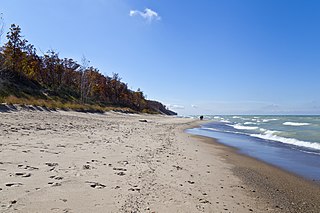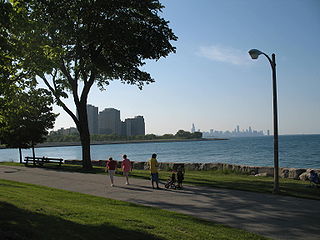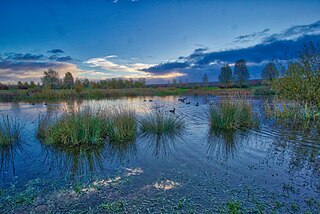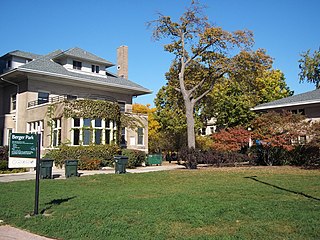Related Research Articles

United States Steel Corporation, more commonly known as U.S. Steel, is an American integrated steel producer headquartered in Pittsburgh, Pennsylvania, with production operations primarily in the United States of America and in several countries across Central Europe. It was the 8th largest steel producer in the world in 2008. By 2018, the company was the world's 38th-largest steel producer and the second-largest in the United Stares behind Nucor Corporation.

Indiana Dunes National Park is a United States national park located in northwestern Indiana managed by the National Park Service. It was authorized by Congress in 1966 as the Indiana Dunes National Lakeshore and was redesignated as the nation's 61st national park on February 15, 2019. The park runs for about 20 miles (32 km) along the southern shore of Lake Michigan and covers 15,349 acres (6,212 ha). Along the lakefront, the eastern area is roughly the lake shore south to U.S. 12 or U.S. 20 between Michigan City, Indiana, on the east and the ArcelorMittal steel plant on the west. A small extension south of the steel mill continues west along Salt Creek to Indiana 249. The western area is roughly the shoreline south to U.S. 12 between the Burns Ditch west to Broadway in downtown Gary, Indiana. In addition, there are several outlying areas, including Pinhook Bog, in LaPorte County to the east; the Heron Rookery in Porter County, the center of the park; and the Calumet Prairie State Nature Preserve and the Hobart Prairie Grove, both in Lake County, the western end of the park.

Parks in Chicago include open spaces and facilities, developed and managed by the Chicago Park District. The City of Chicago devotes 8.5% of its total land acreage to parkland, which ranked it 13th among high-density population cities in the United States in 2012. Since the 1830s, the official motto of Chicago has been Urbs in horto, Latin for "City in a garden" for its commitment to parkland. In addition to serving residents, a number of these parks also double as tourist destinations, most notably Lincoln Park, Chicago's largest park, visited by over 20 million people each year, is one of the most visited parks in the United States. Notable architects, artists and landscape architects have contributed to the 570 parks, including Daniel Burnham, Frederick Law Olmsted, Jens Jensen, Dwight Perkins, Frank Gehry, and Lorado Taft.

The Indiana Harbor and Ship Canal is an artificial waterway on the southwest shore of Lake Michigan, in East Chicago, Indiana, which connects the Grand Calumet River to Lake Michigan. It consists of two branch canals, the 1.25 mile (2 km) Lake George Branch and the 2 mile (3 km) long Grand Calumet River Branch which join to form the main Indiana Harbor Canal.

South Chicago, formerly known as Ainsworth, is one of the 77 well-defined community areas of Chicago, Illinois.

East Side is one of the 77 official community areas of Chicago, Illinois. It is on the far south side of the city, between the Calumet River and the Illinois-Indiana state line, 13 miles (21 km) south of downtown Chicago. The neighborhood has a park on Lake Michigan, Calumet Park, and a forest, Eggers Grove Forest Preserve. The forest preserve has hiking/walking trails, picnic grounds and birdwatching. It is served by U.S. Highway 12, U.S. Highway 20, and U.S. Highway 41.

Hegewisch is one of the 77 community areas of Chicago, Illinois, located on the city's far south side. It is bordered by the neighborhoods of Riverdale and South Deering to the west, the East Side to the north, the village of Burnham to the south and the city of Hammond, Indiana to the east. The community area is named for Adolph Hegewisch, the president of U.S. Rolling Stock Company who hoped to establish "an ideal workingman's community" when he laid out the town along a rail line in 1883, six years before Chicago annexed the town.

The Chicago Park District is one of the oldest and the largest park districts in the United States. As of 2016, there are over 600 parks included in the Chicago Park District as well as 27 beaches, several boat harbors, two botanic conservatories, a zoo, and 11 museums. The Chicago Park District also has more than over 230 field houses, 78 public pools, and dozens of sports and recreational facilities, with year-round programming. The district is an independent taxing authority as defined by Illinois State Statute and is considered a separate agency of the City of Chicago. The district's headquarters are located in the Time-Life Building in the Streeterville neighborhood.

Lake Calumet is the largest body of water within the city of Chicago. Formerly a shallow, postglacial lake draining into Lake Michigan, it has been changed beyond recognition by industrial redevelopment and decay. Parts of the lake have been dredged, and other parts reshaped by landfill. Together with the rest of the city of Chicago, the remnant of the lake now drains into the Des Plaines River and the Mississippi River basin via the Cal-Sag Channel and the Chicago Sanitary and Ship Canal.

The Port of Indiana-Burns Harbor is an industrial area, founded in 1965 and located on the Lake Michigan shore of Indiana at the intersection of U.S. Route 12 and Indiana State Road 249. The primary work done in the area is the manufacturing of steel, and the port area is dominated by steel mills. The port is divided between the municipalities of Burns Harbor and Portage.

Burnham Park is a public park located in Chicago, Illinois. Situated along 6 miles (9.7 km) of Lake Michigan shoreline, the park connects Grant Park at 14th Street to Jackson Park at 56th Street. The 598 acres (242 ha) of parkland is owned and managed by Chicago Park District. It was named for urban planner and architect Daniel Burnham in 1927. Burnham was one of the designers of the 1893 World's Columbian Exposition.
William W. Powers State Recreation Area is an Illinois state park administered by the Illinois Department of Natural Resources on 580 acres (230 ha) in the Hegewisch community area of the City of Chicago in Cook County, Illinois, United States. The area includes 419 acres (170 ha) of water in Wolf Lake that provides about 6 miles (10 km) of shoreline to fishermen. The park hosts about half a million visitors annually. The park contains numerous species, and is one of the most important biological sites in the Chicago region.
The Port of Chicago consists of several major port facilities within the city of Chicago, Illinois, operated by the Illinois International Port District. It is a multimodal facility featuring Senator Dan Dougherty Harbor, the Iroquois Landing Lakefront Terminus, and Harborside International Golf Center. The central element of the Port District, Calumet Harbor, is maintained by the U.S. Army Corps of Engineers.

Miller Beach is a neighborhood of Gary, Indiana on the southernmost shore of Lake Michigan. First settled in 1851, Miller Beach was originally an independent town. However, the "Town of Miller" was eventually annexed by the then flourishing city of Gary in 1918. Located in the northeastern corner of Lake County, Indiana, the former town is now known as "The Miller Beach Community." Miller Beach borders Lake Michigan to the north, Porter County to the east, and is largely surrounded by protected lands, including Indiana Dunes National Park. Miller Beach is also the closest beach/resort community to Chicago, and has been a popular vacation spot since the early 20th century. As of the 2000 US census, it had a population of 9,900.
The Duluth Works was an industrial steel and cement manufacturing complex located in Duluth, Minnesota, United States, in operation 1915 to 1987. The complex was operated by the United States Steel Corporation. Officially, the plant's purpose was to supply the growing Midwest with steel finished products. Unofficially, they were built as part of a "gentleman's agreement" between U.S. Steel and the State of Minnesota to not impose hefty iron ore taxes on U.S. Steel in exchange for a fully integrated steel plant within Minnesota, whose mines furnished 80% of the ore to U.S. Steel. The combined works of the steel and cement plant were the largest employers in Duluth and the fourth largest industrial complex in Minnesota.

Marquette Park, originally called Lake Front Park, is a municipal park completely surrounded by Indiana Dunes National Park. Its primary elements include 1.4 miles (2.2 km) of white sand Lake Michigan beaches, inland ponds, impressively high sand dunes, wetlands, a lagoon, and indigenous oak savanna. The park is located within the Miller Beach community. Miller Beach was once an independent municipality. However, in 1918 shortly before the establishment of Marquette Park, the Town of Miller was forcibly annexed into the municipal boundaries of Gary, Indiana. The park includes the Octave Chanute museum, registered as a National Landmark of Soaring.
Chicago Lakeside Development is a proposed redevelopment of about 600 acres on the former U.S. Steel SouthWorks site on the South Side of Chicago, lying about 10 miles (16 km) south of the Chicago Loop. The plan calls for 13,575 new homes, 17,500,000 square feet (1,630,000 m2) of retail and other commercial space, a new high school, 1,500-slip marina, 125 acres of public land, lakefront access, new bike paths, and commuter rail and bus service would house 150,000 people. The Chicago Lakeside Development Master Plan will take an estimated 25 to 45 years to complete and will cost more than $4 billion in both public and private funds. The project was placed on indefinite hold in February 2016.

Glan Llyn is the name of a mixed-use community development, in the east of Newport, south Wales on the heavy end of the former Llanwern steelworks, at the edge of the Caldicot Moors. The moors have a wealth of buried archaeology of international importance, including prehistoric and Roman landscapes which have been protected and preserved over the years by alluvial deposits.

Berger Park, officially Park #1255 of the Chicago Park District, is a small recreational area bordering Lake Michigan in the Edgewater neighborhood of North Side, Chicago, Illinois. The park features the historic Downey House and Samuel H. Gunder houses.
References
- 1 2 3 4 5 6 7 8 9 10 "South Chicago Industry". Northeastern Illinois University. Archived from the original on 9 April 2011. Retrieved 29 December 2010.
- ↑ "Southeast Side History - PowerPoint" (PDF). Chicago State University. Retrieved 26 October 2018.
- 1 2 3 4 "South Works". Forgotten Chicago. Retrieved 29 December 2010.
- 1 2 "Chicago to Redevelop U.S. Steel Site on Lakefront". The New York Times. 28 December 2010. Retrieved 29 December 2010.
- 1 2 "Dave Matthews Band Caravan: biggest South Side event since '33". Chicago Sun-Times. 9 July 2011. Archived from the original on 11 November 2014. Retrieved 6 November 2011.
- ↑ "Chicago Lakeside Development".
- ↑ ""Lakeside Development Dead After U.S. Steel and McCaffery Interests Split," by Sam Choles". DNAinfo. Archived from the original on 8 March 2016. Retrieved 6 March 2016.
- ↑ "U.S. Steel picks buyer for massive South Works site".
- ↑ "U.S. Steel South Works megadevelopment faces delay over soil contamination".
- ↑ "South Works developer says project is still on".
- ↑ ""Steelworkers Park," Chicago Park District website".
- ↑ ""Park 566 Framework Plan," Chicago Park District website, retrieved 12/25/2015" (PDF).
- ↑ "Hey and Associates, Inc. - Chicago Park District Park 566 Framework Plan". heyassoc.com.